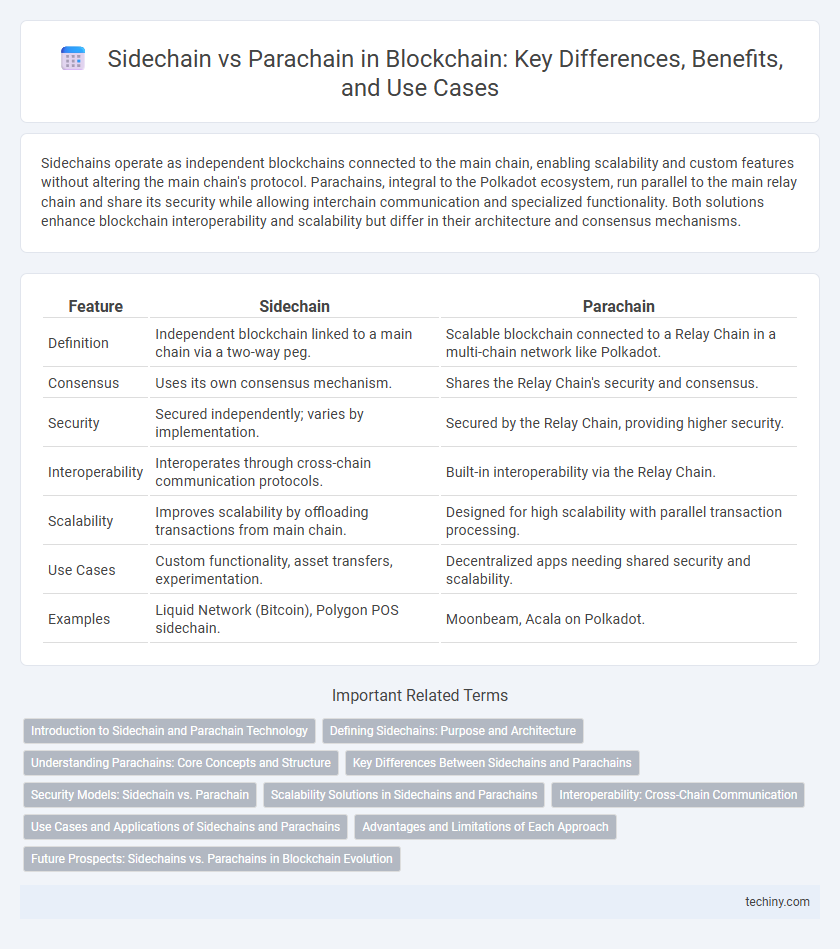Sidechains operate as independent blockchains connected to the main chain, enabling scalability and custom features without altering the main chain's protocol. Parachains, integral to the Polkadot ecosystem, run parallel to the main relay chain and share its security while allowing interchain communication and specialized functionality. Both solutions enhance blockchain interoperability and scalability but differ in their architecture and consensus mechanisms.
Table of Comparison
| Feature | Sidechain | Parachain |
|---|---|---|
| Definition | Independent blockchain linked to a main chain via a two-way peg. | Scalable blockchain connected to a Relay Chain in a multi-chain network like Polkadot. |
| Consensus | Uses its own consensus mechanism. | Shares the Relay Chain's security and consensus. |
| Security | Secured independently; varies by implementation. | Secured by the Relay Chain, providing higher security. |
| Interoperability | Interoperates through cross-chain communication protocols. | Built-in interoperability via the Relay Chain. |
| Scalability | Improves scalability by offloading transactions from main chain. | Designed for high scalability with parallel transaction processing. |
| Use Cases | Custom functionality, asset transfers, experimentation. | Decentralized apps needing shared security and scalability. |
| Examples | Liquid Network (Bitcoin), Polygon POS sidechain. | Moonbeam, Acala on Polkadot. |
Introduction to Sidechain and Parachain Technology
Sidechain technology enables parallel blockchains linked to a main chain, allowing asset transfers and enhanced scalability without compromising security. Parachains are specialized blockchains within the Polkadot ecosystem, connected to a central Relay Chain to share security and interoperability. Both technologies address blockchain scalability by distributing network loads while maintaining decentralized trust.
Defining Sidechains: Purpose and Architecture
Sidechains are independent blockchains attached to a main blockchain, enabling asset transfers and enhanced functionality without congesting the primary network. Their architecture typically includes a two-way peg mechanism, facilitating secure asset movement between the main chain and the sidechain. Sidechains empower scalability and customization by allowing developers to implement distinct consensus algorithms and features tailored to specific use cases.
Understanding Parachains: Core Concepts and Structure
Parachains are specialized, independent blockchains that run parallel to a main relay chain, enabling scalability and interoperability within a blockchain ecosystem like Polkadot. Each parachain benefits from shared security provided by the relay chain while maintaining its unique consensus mechanism and governance structure. This architecture facilitates customized blockchain solutions with seamless communication across diverse networks through cross-chain message passing (XCMP).
Key Differences Between Sidechains and Parachains
Sidechains operate as independent blockchains linked to a main chain, enabling asset transfers and custom consensus mechanisms, while parachains function as scalable, interoperable chains connected to a shared Relay Chain within the Polkadot ecosystem. Sidechains require their own security model, potentially leading to varied security levels, whereas parachains benefit from Polkadot's shared security model, enhancing overall network security. Parachains enable seamless cross-chain communication within Polkadot, whereas sidechains primarily interact with their parent main chain, limiting interoperability.
Security Models: Sidechain vs. Parachain
Sidechains operate as independent blockchains connected to a main chain, relying on their validators for security, which can introduce vulnerabilities if the sidechain's consensus is weak. Parachains, native to the Polkadot ecosystem, benefit from the shared security model provided by the Relay Chain, offering robust protection against attacks through pooled validator resources. This shared security significantly enhances trust and stability for decentralized applications deployed on parachains compared to the isolated security framework of sidechains.
Scalability Solutions in Sidechains and Parachains
Sidechains enhance scalability by offloading transactions from the main blockchain, enabling faster processing and reduced congestion while maintaining asset security through two-way peg mechanisms. Parachains, integral to the Polkadot ecosystem, provide parallelized transaction processing with shared security, allowing multiple chains to run simultaneously and interoperate seamlessly. These scalability solutions optimize throughput and reduce latency, facilitating a high-performance blockchain environment suited for diverse decentralized applications.
Interoperability: Cross-Chain Communication
Sidechains use independent consensus mechanisms allowing assets and data to move securely between a main blockchain and the sidechain, facilitating targeted interoperability for specific use cases. Parachains, built as parallel blockchains connected to a relay chain like Polkadot, enable seamless cross-chain communication and shared security across multiple parachains through a unified network protocol. This architecture supports scalable and efficient interoperability, promoting complex multi-chain decentralized applications and asset transfers.
Use Cases and Applications of Sidechains and Parachains
Sidechains enable scalable and customizable blockchain environments by allowing assets to be transferred from the main chain while supporting diverse applications such as gaming, DeFi, and token issuance. Parachains offer interoperable and specialized blockchain networks within the Polkadot ecosystem, facilitating cross-chain communication and shared security optimized for applications like decentralized finance, supply chain management, and IoT data integration. Both technologies enhance blockchain scalability and functionality but prioritize different use cases; sidechains emphasize independent customization, whereas parachains focus on ecosystem-wide interoperability.
Advantages and Limitations of Each Approach
Sidechains offer enhanced scalability and flexibility by allowing assets and data to move independently from the main blockchain, reducing congestion and enabling customized consensus mechanisms; however, they face challenges in security, as they often rely on less robust validators compared to the main chain. Parachains provide seamless interoperability within a shared security model by connecting directly to a relay chain, ensuring robust security and cross-chain communication, but they require complex slot leasing on the relay chain and may experience limited customization due to shared protocol constraints. Both approaches balance scalability, security, and interoperability differently, with sidechains prioritizing customization and parachains emphasizing integrated security.
Future Prospects: Sidechains vs. Parachains in Blockchain Evolution
Sidechains offer scalability and interoperability by allowing independent blockchains to run parallel to mainnets, enabling customizable consensus mechanisms and enhancing transaction throughput. Parachains, integral to Polkadot's ecosystem, provide a shared security model and seamless cross-chain communication through a central Relay Chain, fostering a more interconnected blockchain environment. Future blockchain evolution favors parachains for scalable, secure, and interoperable networks, while sidechains remain vital for specialized applications requiring tailored protocols and greater autonomy.
Sidechain vs Parachain Infographic

 techiny.com
techiny.com